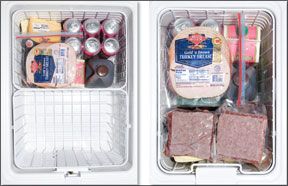Over the last year, weve reviewed everything from thermo-electric coolers to snatch blocks, navigation software, PBO rigging, and even sunscreens. The 2007 Practical Sailor Gear of the Year winners list is no less varied. The general gear winners include the Superwind 350 wind generator, the Fujinon TS 1040 Techno-Stabi and Bushnell Stableview image-stabilized binoculars, the Mercury Big Foot 9.9-horsepower outboard engine, the Force 10 propane galley stove, Digital Antennas 3-dB VHF antenna, Harkens 1609 snatch block, the Kestrel 4000 and Speedtech Skymaster handheld weather instruments, the Norcold 60-quart and Engel 35-quart thermoelectric coolers, and both the Lewmar and Dax Onetouch winch handles. The marine safety gear standouts included the Elliot SOLAS-6 life raft, Mustangs automatic inflatable PFD/harness combo (MD 3184), West Marines Basic harness, the Mustang Integrity float coat, and the Mustang Ocean Commander survival suit. The marine maintenance products that topped our list include Interluxs Micron 66 bottom paint, West Marines CorrosionPro Lube metal protectant, the TC-11 corrosion-inhibiting spray, and the Star brite One-Step Cleaner Wax.
****
Its time once again to name the
Practical Sailor Gear of the Year products. Weve spent the last few weeks thumbing through our 2007 tests and have selected a sampling of the best of the best. Over the last year, weve reviewed everything from thermoelectric coolers to snatch blocks, navigation software, PBO rigging, and even sunscreens. The 2007 winners list is no less varied: From the new, high-tech Fujinon image stabilized binoculars to the tried-and-true Force 10 galley range, these products represent the best of whats out there.
Wind Generators
Practical Sailor
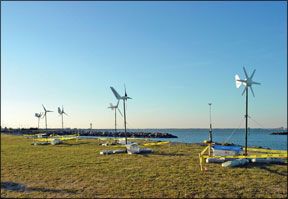
Ralph Naranjo
testers set up five wind generators at an unobstructed waterfront site on the southern Chesapeake Bay in early March 2007. Tests were carried out over four consecutive days-during which output power (in amp hours) was measured and logged, wind speeds were recorded, and noise from the turbines was measured.
The Superwind 350 was the overall winner with regard to putting amp hours in the proverbial battery bank (July 2007). This wind generator, manufactured in Germany, is very well constructed and relatively quiet for a large-rotor unit. It performed well, even on the lightest wind day. Downsides include limited field repair options, a hefty price tag ($1,600), and the fact that it is a newcomer to the U.S. market. Wind generator makers have come and gone over the years, and we hope this three-year-old company sticks around.
The Superwind 350 was the second heaviest unit we tested and the most expensive. The 350-watt unit has three carbon fiber-reinforced blades and produces 12- or 24-volt DC current. The assembled unit weighs approximately 25 pounds and comes with a three-year warranty.
Binoculars
When equipped with image-stabilizing technology, binoculars with over 10x magnification, can provide a clear, sharp image at magnifications more than double what most boaters have ever used on the water. Testers found the Fujinon TS 1040 Techno-Stabi 14×40 system to be the clear winner in our tests (December 2006 and November 2007).
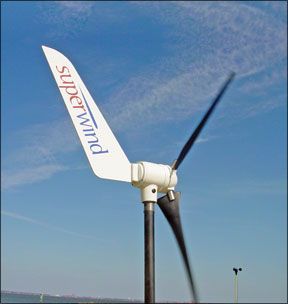
Fujinon uses the most sophisticated stabilization system of all the binoculars we tested. It utilizes input from two piezo gyro vibration sensors-one for the vertical axis and one for the horizontal axis-to detect cyclical and repetitive motion. Plus, it uses the input from another pair of gyro sensors-again one on the vertical axis and one on the horizontal axis-to detect binocular direction.
The IS system in the Fujinon held the image steadier than the others tested and allowed testers to read several markers that were farther than 1 nautical mile from the test boat.
Fujinon ships the Techno-Stabi in a custom-fitted Pelican hard case-excellent protection. The IS binocular costs $999 and comes with a one-year warranty. With all the precise optics and microelectronics in this product, wed like to see the warranty extended to at least two years. We recommend consumers buy IS binoculars only after they acquire a good pair of 7×50 binoculars with a compass.
For those unwilling to shell out $1,000 for a top-of-the-line IS bino, there is another option: The Bushnell 10×35 Stableview. This units performance pleasantly surprised testers. It performed well overall, carries a two-year warranty, and is priced right at $509.
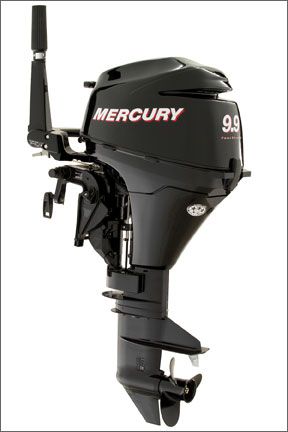
Outboards
In Practical Sailors small outboard testing over the years, weve found that the better engines are usually the ones that are easy to operate, transport, store, and maintain. There have not been major differences in performance, so it carries less weight in our overall conclusions. If you anticipate using your dinghy a great deal and are in the market for a 9.9-horsepower engine, check out the Mercury 9.9, our Best Choice (June 2007) in this power range.
The most user-friendly engine in our test group, the Mercury F9.9M provides peppy performance and runs quietly. At 84 pounds, it was the middleweight in the test. With its large front carrying handle and recessed area below the cowling on the back, you can get a good grip on it. The Mercury did well on the water, pushing a Walker Bay Genesis 270 FTD at a top speed of 17 knots, and noise levels equal to its competitors. At $2,595, it runs $500 more than the Tohatsu MFS 9.8A we tested and $500 less than the Honda BF9.9D6SHA.
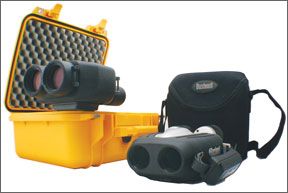
The Mercury was the only test engine with its stop-engine button mounted on the throttle face, keeping the driver from having to turn around to find it. The tiller extends 18 inches from the transom, and the shifter is integrated into the tiller handle. The Mercury Big Foot 9.9 model comes with a 6-amp alternator. This two-cylinder, water-cooled engine requires about a quart of oil. and has a pull-start, with chokes that need to be used only when the engine is cold.
It comes with a standard 3.1-gallon plastic fuel tank, a fuel hose, and an aluminum propeller. It is backed by a three-year warranty, and-along with the other engines tested-it has the highest emissions rating: three stars.
Galley Stoves
The Force 10 propane stove/oven combo (63351) immediately stood out in our test line-up (July 2007), with its mirror-polished 304 stainless-steel exterior. Designed and made for the offshore cruiser, the Force 10 is built to last. It has top-quality construction and safety features.
It has two 4,100-BTU front burners and one 8,200-BTU back burner, each with a screwed-on stainless-steel cap. The Force 10 burners are easy to use, with electronic ignition and ergonomic control knobs that keep users from accidentally turning off the flame when trying to coax it into its lowest setting. The Force 10 has a flame-failure device that shuts off the gas in 10 seconds, if a burner or the oven is accidentally extinguished.
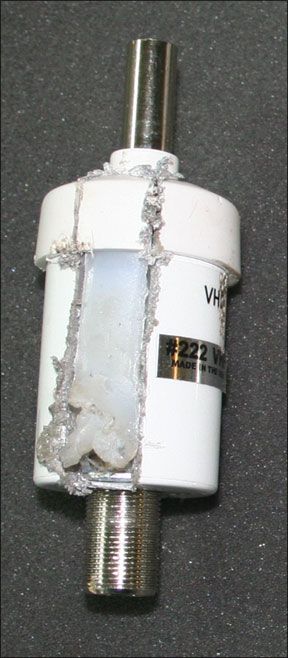
Force 10s signature feature is its fold-away oven door. When open, the door tucks into a slot below the oven and, without the weight of the oven door pulling it forward, the stove tilts very little on its gimbals. The Force 10 oven-once it reached the desired temperature-out-baked the three other ovens in our testing.
VHF Antennas
In the February 2007 issue, we rated 3- and 4-foot 3-dB sailboat antennas. VHF communication is all about height. The tallest mast wins, provided that a good quality coax is used between the VHF and its antenna.
The Digital 222 3 dB was our distance champ by a narrow margin and was, hands down, the most substantial antenna in our test group. When we took the 222 to the bandsaw, we discovered that this antenna had no equal as far as construction design. Unique to the Digital 222, the entire body of the antennas coil is filled with a firm, silicone-type sealant that locks everything inside the coil into one impenetrable, waterproof mass. It is competitively priced at $46. The 222 weighs about 10 ounces, and the 36-inch stainless steel antenna whip is triple the diameter of any other 3-dB antenna we tested. It may not be the right choice for a toothbrush-chopping performance racer, but this antenna shines in its overall range performance and its indestructibility. If you expect icicles in your rigging, heres an antenna you can hang your wool cap on. If
the extra weight is not a concern, this antenna could outlast the boat.
Snatch Blocks
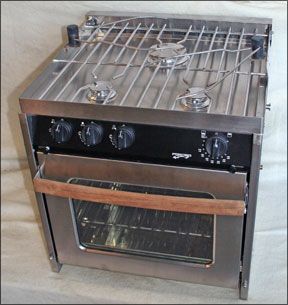
Harkens easy-to-operate, friction-free, front-loading snatch block took our Best Choice kudos for snatch blocks (August 2007). The Harken 1609, a one-hand operated, bottom-opening snatch block, is user-friendly, and its rugged construction promises years of heavy-duty use. The investment-cast stainless-steel body is a chunky piece of metal that adds some extra weight, but it also stabilizes the load handling and provides a secure point to attach the rugged trunnion-action snap shackle. Harken topped the charts with its unique clam shell-like, push-button opening process. The thick rubber padding on the cheeks minimizes gelcoat chipping caused by light-air sheet slackening.
The Harken block was a top performer in testing, is quality constructed, and easy to use and maintain. We found the 1609 model online at
www.defender.com for $299.
Weather Instruments

In our May 2007 review of a dozen weather tools, testers compared devices that ranged from the simple, those that deliver only wind information or wind and temperature, to the complex, those that also record humidity and barometric pressure. The instruments were rated after evaluating the available functions, the price, user-interface, ergonomics, accuracy, intuitiveness, and how useful the device is to sailors.
The Kestrel 4000 was tapped as the
Practial Sailor Best Choice. Testers found it easy to use and not hampered by complicated extras. We particularly liked the graphic records for barometer and temperature. The Kestrels dedicated on/off switch and LCD backlight are other nice details. The sequence of screens is logical and can be accessed in two directions.
With an optional PC interface, the 4000 has added value for the serious weather tracker. It has a tripod mount in the docking station, allowing techies to set it up as a weather station and feed data to the PC. With a $329 price tag (www.nkhome.com), its a good product for the sailor unconcerned about cost who wants a reliable product that offers valuable info.
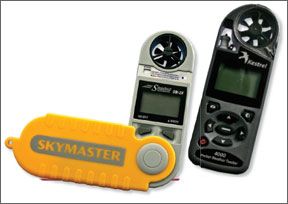
For those with strong eyes who don’t mind the challenge of tiny screen characters, we recommend the $171 Speedtech Skymaster (www.landfallnavigation.com). The Skymaster has a barometer and a wet bulb and measures humidity, dew point, and heat stress index. Its handy and rugged, and most of the information is easy to read (with the exception of the aforementioned under-sized LCD characters). The barometer and temperature screens show bar graphs of past trends, and the unit has an interesting severe-weather alarm.
12-Volt Refrigerators
Compressor-driven portable refrigerators and freezers on the market now are quiet, efficient and effective. Theyve proven to be long lasting and low-maintenance. They are expensive, but if you need the capabilities of one of these units, your best bet is to pick the size that fits your needs and then chose either a Norcold or Engel unit. In May 2007, Practical Sailor tested four compressor-driven portable refrigerator/freezers. The Norcold MRFT 60 froze out the competition with its cavernous 60-quart interior and superior cooling abilities. The unit performed exceptionally well, cooling a gallon of 100-degree water to 12 degrees and dipping to -2 degrees in an overnight cooling test. Five hours after power was shut off, the Norcold interior remained a chilly 43 degrees.

The swing compressor drew only 3.1 amps, and noise levels stayed below 50 decibels during testing. If the $999 price tag (www.pplmotorhomes.com) doesn’t chill you, our Best Choice can hold a six pack of Coke, a six pack of beer, a half-gallon of lemonade, a half-gallon of ice tea, and a weeks worth of turkey, ham, and cheese-and thats just one side of the cooler.
The Engel MT-35, our Budget Buy at $649 (www.eco-fridge.com), was a top performer with an efficient compressor and 35 quarts of interior space. We were able to adjust temperatures inside, setting them at different spots between 0 and 50 degrees, making this unit useful as a fridge or a freezer. Like the Norcold, the exterior is powder-coated and galvanized steel with a bright white plastic interior for easy cleaning. The unit drew only 2 amps, put out less than 50 decibels of noise, chilled the interior to 9 degrees in one hour, froze to 7 degrees overnight and was able to maintain 47 degrees five hours after power had been shut off.

Ralph Naranjo
0)]
Onetouch Winch Handles
One of the most innovative pieces of equipment to come across our desks this year was the OneTouch winch handle. We reviewed the Lewmar product in February 2007 and Dax Labs OneTouch in the November issue. The Dax handle is manufactured by OneTouch creator and engineer Don Steiner, who sold the license for the metal version to Lewmar.
Both use the same new, yet simple, technology. The OneTouchs unique quick-release button, which runs the length of the handle arm, allows users to grab anywhere on the arm to release or set the locking mechanism. This time-saver also saves users the frustration of fumbling with a standard locking handle.
Ralph Naranjo

1)]
The design employs a cam rod with two steel pins that retract into the octagon when the handles arm is squeezed, releasing the lock; they protract when the handle is released, engaging the lock. This means setting and removing the handle can be done with one hand, in one motion.
Both the Lewmar and the Dax handles have earned a spot on our Gear of the Year list. They are both quality products. Where they differ is in construction materials-the Lewmar is aluminum while the Dax is made of the lighter-weight 50-percent fiber-filled nylon-and the Dax has a wider grab bar. Both measure 10 inches, for better purchase power, and both come in single grip or power (palm) grip; the Lewmar also comes in a double grip.
We found the Lewmar power grip online at
www.defender.com for $86, and the Dax power grip retails for $104 at www.onetouchhandle.com.






























